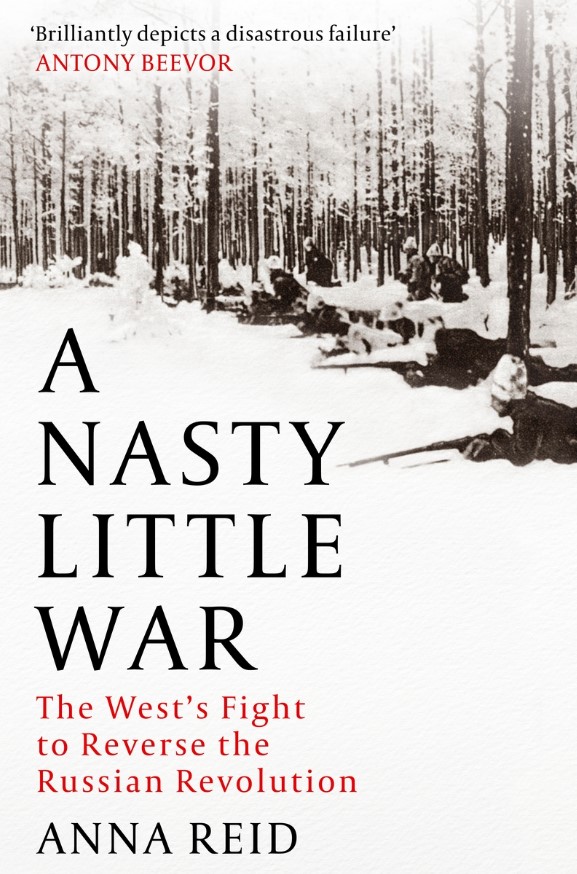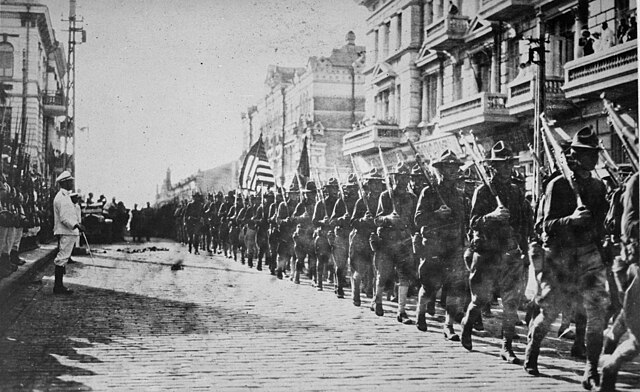
By Anna Reid, Published by John Murray Press, 2023, £19-95
Reviewed by Oscar Parry

Anna Reid’s history of the ‘intervention’ in Russia after the 1917 revolution, when 180,000 troops from imperialist powers were sent to support the counter-revolutionary ‘White’ armies, is meticulously researched but politically bereft. Reid fails to link the crushing defeat of the capitalist armies in the ensuing civil war with the popularity of the October revolution amongst the working class and peasantry – both in Russia and abroad. She attempts to portray the Bolsheviks as authoritarian and violent throughout the book, but undermines her own arguments with her descriptions of the brutal massacres initiated by the White forces.
The aim of the intervention was, in Winston Churchill’s words, to “strangle Bolshevism in its cradle”. By the time the imperialist armies arrived in force, in the summer of 1918, two dozen different ‘governments’ functioned on the territory of the former Russian empire. The Whites were beset by infighting and corruption. Reid highlights the tension between the different forces involved, ranging from avowedly ‘socialist’ groups like the Mensheviks to ex-Tsarist generals Alexander Kolchak, Anton Denikin and Nikolai Yudenich.
One thing they all had in common was a burning hatred for the Bolsheviks. Direct conflict often broke out amongst the Whites; British General Poole instituted a coup of the supposedly ‘democratic’ Northern Government – the first of several ‘left’ administrations to be ousted by the right with interventionist help. Poole banned public meetings, censored newspapers, threatened capital punishment for Bolshevik propaganda, and arrested dozens of ‘politicals’.
The strength of the book lies in its recognition of the brutality of the Whites, who engaged in the mass executions of prisoners and civilians. They carried out widespread pogroms against the Jewish population, forcing hundreds of thousands from their homes and killing an estimated 200,000. The various British military missions used the White ‘Jew equals Bolshevik’ smear in their own Russian language propaganda, most mission members believing it themselves. Antisemitism was rife amongst the British establishment. Churchill believed revolution was being plotted worldwide by ‘international’ and ‘terrorist’ Jews.
The allies were massively overconfident about the weakness of the Bolshevik government. An American ambassador in Russia cabled on the morning of the October revolution that the new regime would “collapse within a few days”, while Churchill believed that Bolshevism was supported by “a mere fraction” of the Russian public, and would be “swept away by a general election held under Allied auspices”.
Reid doesn’t pull back from calling the intervention a failure, but she fails to draw out the political conclusions that led to its defeat. She argues throughout the book that both the Whites and the Bolshevik forces, commonly referred to as the Red Army, were equally guilty of extra-military violence and that both armies used conscription to grow their ranks. She fails to connect the observation of a British officer – that the “peasants first questions… were always with respect to Denikin’s agrarian policy” – with the massive growth of the Red Army over the course of the civil war, while the Whites were beset by constant mutinies and desertions.
Reid goes into very little detail about how the Red Army was formed – initially consisting of groups of armed workers from Moscow and St Petersburg. The embryo of the proletarian revolution spread into the countryside and the outer provinces, beginning to build up a Soviet system across the former Russian empire. As the counter-revolutionary forces regrouped, the limits to the spread of the revolution became determined by military means, and a professional army was needed to defend the gains of October. Trotsky co-ordinated the Red Army from an armoured train, and wrote in his memoir My Life that “the strongest cement in the new army was the ideas of the October Revolution, and the train supplied the front with this cement”.

A major factor leading to the defeat of the Whites was their inability to offer any solution to the national demands of the oppressed minorities of the Russian empire. Russia was formed not as a national state, but as a state made up of nationalities. Under the Tsarist regime the minority ethnicities in the empire were brutally repressed. During the brief reign of the capitalist provisional government from February to October 1917, all nationalities were granted equal rights on paper, but the ruling ethnic Russian bourgeoisie continued to plunder the natural resources of the empire and dominated the state apparatus across the country.
The Bolsheviks’ policy on the right of any nationality to self-determination, including the right to form their own state if they choose, allowed the party to win over the support of the oppressed nationalities to the Soviet regime. But as Trotsky wrote in The History of the Russian Revolution, that was only one side of the matter: “The policy of Bolshevism in the national sphere had also another side, apparently contradictory to the first but in reality, supplementing it. Within the framework of the party, and of the workers’ organisations in general, Bolshevism insisted upon a rigid centralism, implacably warring against every taint of nationalism which might set the workers against one another”. This allowed the Red Army, composed of a myriad different nationalities, to fight as one cohesive force, while the nationalist White armies of the border regions were constantly declaring war against each other.
Reid’s hostility to the Bolsheviks comes through clearly in her book. She describes Lenin as an “obscure revolutionary… a small balding man in a three piece suit” and argues that the “Bolsheviks were at least as authoritarian as the Tsars”, citing Lenin’s order to close down opposition newspapers. However, this completely one-sided analysis fails to mention that this occurred only after these political parties joined the side of the imperialist counter-revolution in the developing civil war.
The Bolsheviks were not in favour of banning any political party, not even the bourgeois parties, as long as they did not take up armed struggle against the revolution. Immediately after the October revolution, the only organisation banned was the Black Hundreds, a proto-fascist party which had been at the forefront of the repression of workers’ organisations under Tsarism.
The attitude of the supposedly ‘socialist’ Mensheviks and Social Revolutionaries to the Bolsheviks is revealed by Trotsky in his book Between Red and White. He quotes the report of the Georgian Menshevik Evgeni Gegechkori to Denikin: “I may state that the struggle against Bolshevism is ruthless on our part. We are crushing Bolshevism by all available means”. Communist newspapers were suppressed, meetings dispersed by gunfire, revolutionary villages led by Bolsheviks were burnt down. The Georgian Menshevik Noe Zhordania stated, “I prefer the imperialists of the West to the fanatics of the East”. It was in the context of this situation, as well as the attempted assassination of Lenin by a Social Revolutionary, that these newspapers were shut down.
Reid argues that “the Bolsheviks used political violence from the start”. In reality, the insurrection which brought the Bolsheviks to power in the October revolution was overwhelmingly peaceful, fully supported by the worker, peasant and soldier masses through the democratic structures of the Soviets. Widespread violence arose from the murderous armed resistance of the dispossessed landlords and capitalists who initiated the civil war, aided by the imperialist powers.
The working class, by contrast, was incredibly generous. Admiral Kolchak was initially arrested for attempting to suppress the October revolution, but later released on the promise that he would not engage in armed struggle. He then went on to lead the counter-revolutionary forces, killing many of the Bolsheviks’ leading members.
Reid also writes that “Stalinism was not a departure from Leninism, but the same philosophy taken to its extreme”. The idea that Stalinism, the consolidation of a privileged totalitarian bureaucratic elite in Russia, and Stalin’s policy that proletarian revolution could be confined to ‘socialism in one country’, was somehow an organic outgrowth of Lenin’s theory of worldwide international revolution and a democratically run socialist society, is an incredible statement. Indeed, in order to consolidate his bureaucratic regime, Stalin brutally murdered all the remaining elements of the original Bolshevik party in his infamous purges, including having Leon Trotsky, the leader of the Left Opposition – which fought back against the betrayal of the ideals of the revolution – murdered in Mexico. A river of blood exists between the ideas of Lenin and Stalin.
Reid fails to identify the reasons the imperial powers were forced to withdraw from Russia. She does mention some examples of soldiers’ strikes and pro-Bolshevik demonstrations, but she follows these with the conclusion that the soldiers did not want “revolution, but demobilisation”. In fact, the leaders of the imperialist coalition were terrified that the army would completely revolt. A report to the British Deputy Chief of the Imperial General Staff, in March 1919, pointed out the “unreliable state of the troops” in North Russia, who were “inclined to be mutinous” and susceptible to “active and insidious Bolshevik propaganda”. The Chief of the Imperial General Staff, Sir Henry Wilson, thought that the British army was a “mine which may go up at any minute”, and urged Lloyd George to withdraw from Russia as quickly as possible.
Reid barely mentions the industrial struggle in Britain, which was a key factor preventing the ruling class from committing their full forces to Russia. In January 1919 a strike wave was unleashed, with 40,000 in Belfast and 100,000 in Glasgow taking action, while many workers in London threatened to come out in solidarity. A general strike was inherent in the situation. At exactly the same time the most serious mutiny of soldiers was taking place in Calais. Indeed, only the failure of the leadership of the trade unions and the Labour Party to lead a decisive struggle for power led to the strike wave subsiding in Britain. The plans of the British ruling class for war in Russia were paralysed by the events of 1919. Wilson drew up emergency plans to deploy troops around London and even suspected the prime minister Lloyd George, wondering in his diary whether he was a secret ‘Bolshevist’ and ‘traitor’. Lloyd George recognised the potential severity of the situation, arguing that “the danger from Bolshevism is not in Russia, but here at home”.
The economic crisis in the imperialist economies was compounded by the trade embargo imposed on the Bolsheviks. Before the war, Russia supplied a quarter of the world’s wheat exports and four-fifths of its flax. Lloyd George was eventually forced to sign a trade deal with the Soviet government, stating “when people are hungry, you cannot refuse to buy corn in Egypt because there is a pharaoh on the throne”.
Overall the book unearths some fascinating details, although Reid’s delving into individual British officers’ affairs and opinions of life in Russia quickly becomes repetitive and dull. Her political conclusions fall into the classic ‘liberal’ position of condemning the violence on both sides of the war, without recognising the life-and-death struggle the Bolsheviks were engaged in to protect the October revolution from being crushed by the imperialist invasion. It was the massive support for the October revolution by workers and soldiers across the world, who rose up in mutinies and strikes, which prevented the imperialist armies from using the full weight of their military power against the newly-formed workers’ state. Indeed, it was only the lack of a revolutionary party like the Bolsheviks which led to the defeat of workers’ revolts in so many countries in the period following the Russian revolution, and contained the spread of the October revolution internationally, paving the way for the consolidation of the Stalinist counter-revolution.






